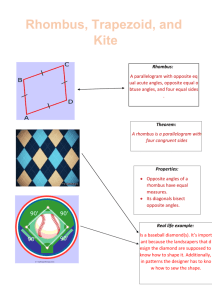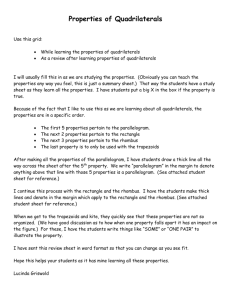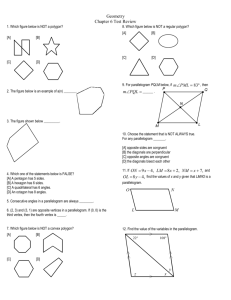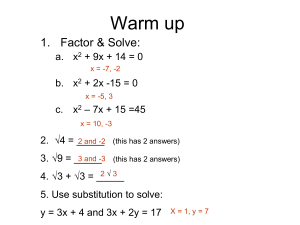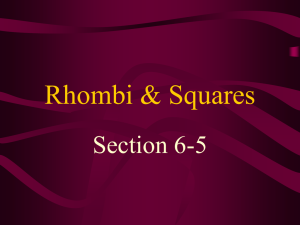No Slide Title - Coweta County Schools
advertisement
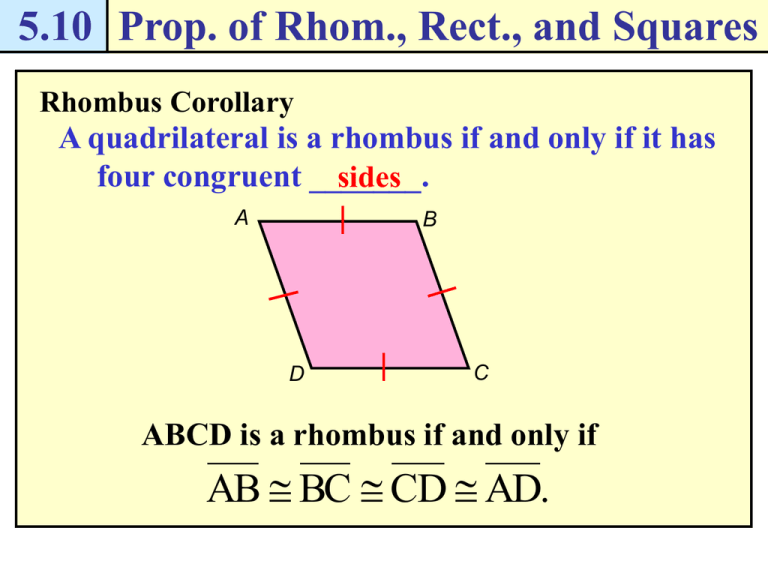
5.10 Prop. of Rhom., Rect., and Squares Rhombus Corollary A quadrilateral is a rhombus if and only if it has four congruent _______. sides A B D C ABCD is a rhombus if and only if AB BC CD AD. 5.10 Prop. of Rhom., Rect., and Squares Rectangle Corollary A quadrilateral is a rectangle if and only if it has four _____________. right angles A B D C ABCD is a rectangle if and only if A, B, C, and D are right angles. 5.10 Prop. of Rhom., Rect., and Squares Square Corollary A quadrilateral is a square if and only if it is a rectangle ________ rhombus and a __________. A B D C ABCD is a square if and only if AB BC CD AD and A, B, C, and D are right angles. 5.10 Prop. of Rhom., Rect., and Squares Example 1 Use properties of special quadrilaterals For any rhombus RSTV, decide whether the statement is always or sometimes true. Draw a sketch and explain R S your reasoning. a. S V a. By definition, a rhombus is a parallelogram with four sides congruent _______. V T By Theorem 5.19, opposite angles of congruent So, S V. a parallelogram are ___________. always true. The statement is _________ 5.10 Prop. of Rhom., Rect., and Squares Example 1 Use properties of special quadrilaterals For any rhombus RSTV, decide whether the statement is always or sometimes true. Draw a sketch and explain your reasoning. S R b. T V b. If rhombus RSTV is a square then all four angles _______, are congruent right angles V square So T V if RSTV is a ________. squares Because not all rhombuses are also ___________, sometimes true. the statement is ___________ T 5.10 Prop. of Rhom., Rect., and Squares Example 2 Classify special quadrilaterals Classify the special quadrilateral. Explain your reasoning. The quadrilateral has four congruent _____. sides right angle One of the angles is not a ____________, square so the rhombus is not also a ________. By the Rhombus Corollary, the quadrilateral is a rhombus __________. 127o 5.10 Prop. of Rhom., Rect., and Squares Checkpoint. Complete the following exercises. 1. For any square CDEF, is it always or sometimes true that CD DE? Explain your reasoning. C D F E By the Square Corollary, all the sides are congruent. Therefore, it is always true. 5.10 Prop. of Rhom., Rect., and Squares Checkpoint. Complete the following exercises. 2. A quadrilateral has four congruent sides and four congruent angles. Classify the quadrilateral. 4 x 360 x 90 o C x x x x D o By the Square Corollary, all the sides are congruent and all angles are right angles. The quadrilateral is a square. F E 5.10 Prop. of Rhom., Rect., and Squares Theorem 5.26 A parallelogram is a rhombus if and only if its diagonals are _____________. perpendicular A B D C ABCD is a rhombus if and only if ____ AC ____ BD . 5.10 Prop. of Rhom., Rect., and Squares Theorem 5.27 A parallelogram is a rhombus if and only if each diagonal bisects a pair of opposite sides. A B D C ABCD is a rhombus if and only if BAD AC bisects ____ BCD and ____ ADC . BD bisects ____ ABC and ____ 5.10 Prop. of Rhom., Rect., and Squares Theorem 5.28 A parallelogram is a rectangle if and only if its diagonals are __________. congruent A B D C ABCD is a rectangle if and only if ____ AC ____ BD . 5.10 Prop. of Rhom., Rect., and Squares Example 3 List properties of special parallelograms F Sketch rhombus FGHJ. List everything you know about it. Solution G By definition, you need to draw a figure with the following properties: parallelogram J • The figure is a _______________. H sides • The figure has four congruent _______. Because FGHJ is a parallelogram, it has these properties: • opposite sides are ________ parallel and ___________. congruent • opposite angles are __________. congruent Consecutive angles are supplementary _________________. • diagonals ________ bisect each other. perpendicular By Theorem 5.26, the diagonals of FGHJ are _______________. By Theorem 5.27, each diagonals bisect a pair of _____________. opposite angles 5.10 Prop. of Rhom., Rect., and Squares Example 4 Solve a real-world problem Framing You are building a frame for a painting. The measurements of the frame are shown at the right. a. The frame must be a rectangle. Given the measurements in the figure, can you assume that it is? Explain. Solution No, you cannot. The boards on opposite sides are the same length, so they form a ______________. parallelogram right angles But you do not know whether the angles are ______________. 5.10 Prop. of Rhom., Rect., and Squares Example 4 Solve a real-world problem Framing You are building a frame for a painting. The measurements of the frame are shown at the right. b. You measure the diagonals of the frame. The diagonals are about 25.6 inches. What can you conclude about the shape of the frame? Solution By Theorem 5.28, the diagonals of a rectangle are congruent __________. The diagonals of the frame are congruent __________, so the frame rectangle forms a ______________. 5.10 Prop. of Rhom., Rect., and Squares Checkpoint. Complete the following exercises. 3. Sketch rectangle WXYZ. List everything you know about it. The drawing of WXYZ is a parallelogram with four right angles. W X Z Y It has these characteristics: • opposite sides are parallel and congruent. • opposite angles are congruent and consecutive angles are supplementary. • diagonals bisect each other and are congruent. 5.10 Prop. of Rhom., Rect., and Squares Checkpoint. Complete the following exercises. 4. Suppose the diagonals of the frame in Example 4 are not congruent. Could the frame still be a rectangle? By Theorem 5.28, a rectangle must have congruent diagonals. 5.10 Prop. of Rhom., Rect., and Squares Pg. 331, 5.10 #2-24 even, 25
